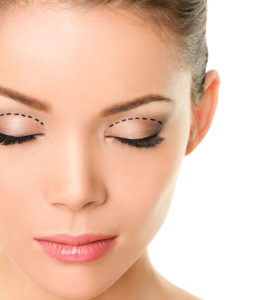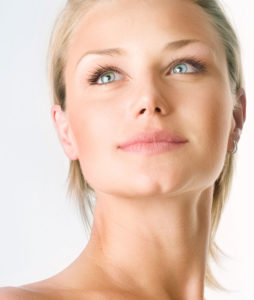Eyelid Surgery- Blepharoplasty
Blepharoplasty (Eyelid surgery) is a procedure used to correct lowered eyelids.

During this type of surgical intervention, the doctor removes skin, muscle, and sometimes fat that can cause the eye area to appear relaxed.
Who is a Good Candidate for Eyelid Surgery?
Eyelid corrective surgery is a procedure that is primarily sought out by people who want an anti-aging treatment.
The skin around your eyes loses elasticity and relaxes over time, this is a natural part of aging. This surgery may help improve and reverse these aging effects, you can consider this type of surgery if you feel it distorts your appearance. Patients also may choose blepharoplasty if they have very visible bags under the eyes or if the skin around the eyebrows begins to fall.
Blepharoplasty, maybe the best option for some people who wish to improve their looks and overcome their cosmetic problems. You may also be a good candidate for this procedure if the dropped eyelids affect your vision.
Why does the skin around the eyes age so fast?
It is known that the first visible wrinkles usually occur precisely around the area of the eyelids. This is because the skin in these places is very thin and very quickly loses its elasticity that is characteristic and implicit younger people. As a result of this fine skin losing elasticity, by your middle ages, many people will form wrinkles (wrinkles) in the area around the eyelids, which contribute to the appearance of an older face.
This is already sufficient enough reason to think about the Blepharoplasty.
One of the most popular facial rejuvenation treatments, correction of the eyelids in Atlas general hospital can not only refresh and rejuvenate your look, but also increase self-confidence in your own appearance.
Preparation for Eyelid correction surgery (Blepharoplasty)
The preparation for eyelid surgery is as follows:
First, you will need initial consultations with a plastic surgeon to discuss your problems and the desired outcome of the operation.
At the beginning of the procedure, the aesthetic surgeon will perform physical examination of the eyes, as well as an examination of your sight.
The surgeon will also take several pictures of your eyelids which will be used as reference.
You will probably be asked to stop taking all medicines or supplements that increase the risk of bleeding, such as ibuprofen or warfarin. It would also be advisable to stop smoking or reduce (if you are a smoker) a few weeks before blepharoplasty.
How is Blepharoplasty performed?
When it comes to Blepharoplasty procedure, in most cases it is performed under local anesthesia, general anesthesia is rarely used.
First, the upper eyelids are worked on. The rule is that the location of the cut is selected so that the scar is completely hidden and invisible. Here the surgeon will make a small cut and remove excess skin, as well as muscles, and sometimes fats. Some of these tissues can be moved to other areas that surround the eye, before the surgeon closes the cut.
Blepharoplasty of lower eyelids usually involves the removal of fat (fat tissue), which contribute to the formation of bags under the eyes, and sometimes remove a small amount of skin. The cut can be made inside the eyelid or the outside under the lower eyelashes.
With the correction of the eyelids, you can usually go home pretty soon after the intervention.
Recovery Post Blepharoplasty Surgery

Blepharoplasty recovery is relatively short one compared to some other types of surgery. If there is no complication, you can go home the same day.
It is important to rest a few days immediately after the eyelid surgery. You may experience swelling and pain. Your doctor may recommend that you take painkillers to help alleviate these symptoms. It may take 1-2 weeks for the symptoms to pass completely. You can also use cold pads for a few days.
Blurred vision and light sensitivity are also possible short-term adverse effects. However, call your doctor if these symptoms last longer than 1-2 days.
You cannot wear contact lenses for two weeks after eyelid surgery.
You do not need to keep your eyes covered during the entire recovery phase, but you may be sent home with a gauze over your eyes to protect the treated area.
What are the risks of this operation?
These types of surgeries usually carry the risk of bleeding, bruising and infection. Blood clots are mostly rare, but they certainly pose a serious risk.
Other risks and complications of eyelid surgery include:
– blurred vision
– damage from excessive exposure to the sun
– dry eyes
– Itching around the eye
– inability to close eyes
– muscle damage
– scars
Eyelid surgery rejuvenates the appearance of the face
Sometimes aesthetic correction of the eyelids is used in combination with some other related surgical procedure to improve the end results. Some people with significantly lower eyebrows may opt for a simultaneous eyebrow intervention.
Others may even be subjected to a face-lift in order to simultaneously solve other cosmetic problems.
You will discuss all these fine details with your surgeon at the very beginning of the procedure. You should be absolutely free to express all your wishes, and you will make the final decision only when you receive all the necessary information.
Eyelid correction (blepharoplasty) is therefore primarily used to reduce common signs of aging that develop around the eye. Relaxed eyelids make the face look tired and old. Surgical intervention with which the eyelids are tightening aims to restore freshness, cheerfulness and youthful appearance to the eyes and face. Tightened of the eyelids give a visual impression that we are awake, relaxed and in a good mood.
For more information, call the Atlas General Hospital Call Center: +381 11 785 88 88 or + 381 60 3292411
- How long do results last?
-
Results of eyelid surgery typically last many years, depending on a variety of individual factors. The effects, however, are not permanent. You can often extend the outcome by maintaining good health following surgery.
- Can I combine upper and lower eyelid surgery?
-
Yes. In fact, for many of our patients, combining upper and lower blepharoplasty can offer the most optimal results.
- What is a blepharoplasty?
-
Blepharoplasty, also called eyelid surgery, is a procedure designed to treat excess skin and fatty tissue of the upper and lower eyelids.
- Is there a specific age to consider blepharoplasty?
-
Anatomic indicators, not age, determine candidacy for eyelid surgery. We often see patients between the ages of 25 and 85 years of age requesting this procedure. As the rate people experience age and environmental effects can be highly individual, our cosmetic enhancement treatments are customized to suit each patient.
